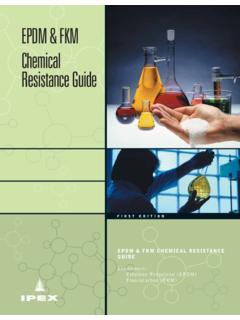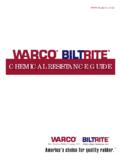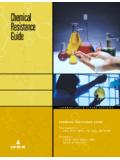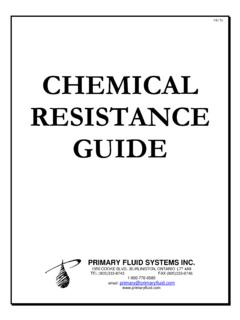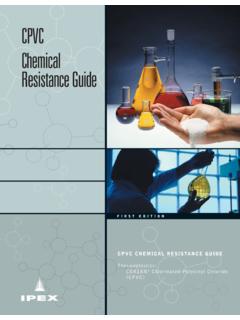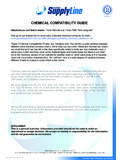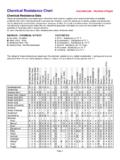Transcription of DuPont™ Kalrez® Chemical Resistance and Fluid ...
1 DuPont Kalrez Chemical Resistance and Fluid Compatibility, Including All Chemicals Under the Clean Air Act Technical Information Rev. 4, July 2010 DuPont Kalrez perfluoroelastomer parts combine the elastomeric properties of fluoroelastomers with the Chemical Resistance of DuPont Teflon fluoropolymer resins. Due to its unique properties, Kalrez parts should be considered for service in all applications and environments where dependable, long-term service is desired, as well as in hot or aggressive environments that are beyond the service ability of common elastomers.
2 This guide is intended to provide assistance in determining the suitability of seven commercially available elastomers nitrile (NBR), ethylene propylene (EPDM), silicone (VMQ), fluorosilicone (FVMQ), vinylidene fluoride-based fluoroelastomer (FKM), polysulfides (T), and Kalrez perfluoroelastomer parts for service in over 1,600 chemicals and fluids. The criteria used for these ratings included volume swell Resistance based on laboratory immersion testing, laboratory aging tests, actual field experience, and informed judgments based on experience in similar Chemical groups.
3 The ratings for the six common elastomers are based on published literature and are offered for general comparative purposes only we cannot guarantee their accuracy nor assume responsibility for their use. Thermal Stability The ratings for these six common elastomers may be overly optimistic for elevated temperature and/or high concentration applications because many are based on ambient temperature testing. Suitability of these elastomers for service at elevated temperatures rapidly diminishes because higher temperatures increase the effects of chemicals on the base polymer as well as the cross-link systems.
4 Serviceability is further limited by the upper service temperature limit of each polymer. As an example, consider a specific case involving an FKM with an upper service temperature limit of nominally 204 C (400 F). Many sources will show an A rating for FKM suitability in toluene service, a common Chemical . However, immersion testing of commonly available FKM O-rings at a slightly elevated temperature of 50 C (122 F) for 168 hours shows a volume swell exceeding 24% and significant loss of physical properties surely warranting a C rating. Similar tests with Kalrez perfluoroelastomer parts, however, show that Kalrez performs well up to 316 C (600 F).
5 Upper Service Temperature Limit DuPont Kalrez 7075 327 C (620 F) DuPont Kalrez 4079 316 C (600 F) DuPont Kalrez 3018 288 C (550 F) DuPont Kalrez 1050LF 288 C (550 F) DuPont Kalrez 6375 275 C (527 F) DuPont Kalrez 2037 220 C (428 F) NBR 107 C (225 F) EPDM 149 C (300 F) VMQ 204 C (400 F) FVMQ 190 C (375 F) FKM 204 C (400 F) T 150 C (302 F) Note: These limits are based on air oxidative stability; limits when exposed to specific chemicals are often much lower. Additionally, these elastomers are commercially available in different grades of polymer and can vary in compound ingredients different grades and compounds within a polymer class can have significantly different performance characteristics.
6 100 C (212 F) was chosen as the baseline comparison for the elastomers in this guide. Chemical Resistance Because DuPont Kalrez has outstanding Chemical Resistance , it withstands nearly all classes of chemicals. With this combination of high thermal stability and excellent Chemical Resistance , the Kalrez perfluoroelastomer parts rating may be conservative, as actual field experience and the example above have demonstrated. In comparing the Chemical and Fluid Resistance of Kalrez perfluoroelastomers to that of DuPont Teflon fluoropolymer resins, certain differences should be kept in mind: Kalrez parts are an amorphous low-modulus rubber whereas Teflon is a crystalline high-modulus plastic.
7 In Fluid environments where high permeation occurs, Kalrez will probably swell to a greater extent than Teflon , even though the polymer is not chemically attacked. Environments in which this is most noticeable are fully halogenated solvents, Freon , and Freon alternatives. Service ability of Kalrez parts in these environments will be dependent upon the specifics of the application. As with all elastomers, it is necessary to compound Kalrez perfluoroelastomers parts with fillers and curatives to gain desired mechanical properties for functionality. In a limited number of environments, even though the polymer is stable, the fillers and curative systems may interact with the chemicals.
8 However, because the level of fillers in Kalrez parts is much lower than in most other elastomers, such filler interactions are generally negligible with Kalrez parts. Where such interactions can occur, such as in highly oxidative environments, service performance is dependent on the conditions of the application and may be affected by compound choice. Because each application is unique, it is recommended that users of Kalrez perfluoroelastomer parts always conduct their own evaluations to determine the suitability of Kalrez for their application. Because of laboratory constraints and differences in field applications, the results shown in this technical information may be based on conditions that may not necessarily reflect actual operating environments for a specific application.
9 Additionally, many elastomeric materials may show excellent Chemical Resistance to pure reagents in relatively short-term laboratory tests. However, they may fail in actual service because of Chemical attack by additives and/or impurities. Kalrez perfluoroelastomer parts, with their near-universal Chemical Resistance , provide an extra degree of safety against these unknown corrosive influences. Case histories are available from your authorized Kalrez distributor detailing proven performance of Kalrez parts in over 100 specific Chemical applications. Information on test performance in a limited number of specific chemicals is also available through your authorized Kalrez distributor.
10 Caution DuPont Kalrez perfluoroelastomer parts, like all fluorinated products, should not be exposed to molten or gaseous alkali metals, such as sodium and potassium, because a highly exothermic reaction may occur. At elevated temperatures above 100 C (212 F), service life may be significantly reduced in fluids containing high concentrations of some diamines, nitric acid, and basic phenols. Kalrez parts should always be tested for suitability. Rating System A Elastomer shows little or no effect (generally less than 10% swell) after exposure to the Chemical ; slight swelling or loss of properties may occur under severe conditions but this should not affect performance.
